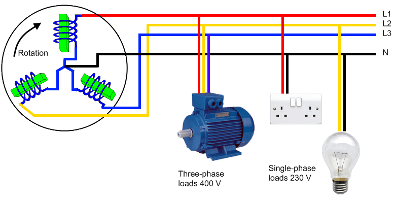Power Phase
What is Electrical Power Phase?

The generation of AC electric power is commonly three phase, in which the waveforms of three supply conductors are offset from one another by 120°. Standard frequencies are either 50 or 60 Hz.
Single Phase
Single-phase distribution is used when loads are mostly lighting and heating, with few large electric motors. In electrical engineering, single-phase electric power refers to the distribution of electric power using a system in which all the voltages of the supply vary in unison. A single-phase load may be powered from a three-phase distribution system either by connection between a phase and neutral or by connecting the load between two phases. Single-phase loads may be connected to a three-phase system, either by a phase-to-phase connection, or by connecting between a phase conductor and the system neutral, which is either connected to the center of the Y (star) secondary winding of the supply transformer, or is connected to the center of one winding of a delta transformer. Single-phase loads should be distributed evenly between the phases of the three-phase system for efficient use of the supply transformer and supply conductors. The line-to-line voltage of a three-phase system is 3 times the line to neutral voltage. Where the line-to-neutral voltage is a standard utilization voltage, individual single-phase utility customers or loads may each be connected to a different phase of the supply. Where the line-to-neutral voltage is not a common utilization voltage, single-phase loads must be supplied by individual step-down transformers. In multiple-unit residential buildings in Canada, lighting and convenience outlets can be connected line-to-neutral to give the 120 V distribution voltage (115V utilization voltage), and high-power loads such as cooking equipment, space heating, water heaters, or air conditioning can be connected across two phases to give 208 V. This practice is common enough that 208 V single-phase equipment is readily available in North America. Attempts to use the more common 120/240 V equipment intended for three-wire single-phase distribution may result in poor performance since 240 V heating equipment will only produce 75% of its rating when operated at 208 V. No arrangement of transformers can convert a single-phase load into a balanced load on a three phase system. Single-phase power distribution is used especially in rural areas, where the cost of a three-phase distribution network is high and motor loads are small and uncommon. Two phase power, meaning the simultaneous provision of sine wave and cosine wave electricity (that is, 90 degrees out of phase) is no longer widely used. But sometimes it is incorrectly described split single phase services as "two phase", when in fact such services are really still single phase power.
Three Phase
Three-phase is a common method of electric power transmission. It is a type of system used to power motors and many other devices. Three phase systems may or may not have a neutral wire. A neutral wire allows the three phase system to use a higher voltage while still supporting lower voltage single phase appliances. In high voltage distribution situations it is common not to have a neutral wire as the loads can simply be connected between phases - phase-to-phase connection. Three phase has properties that make it very desirable in electric power systems. Firstly the phase currents tend to cancel one another (summing to zero in the case of a linear balanced load). This makes it possible to eliminate the neutral conductor on some lines. Secondly power transfer into a linear balanced load is constant, which helps to reduce generator and motor vibrations. Finally, three-phase systems can produce a magnetic field that rotates in a specified direction, which simplifies the design of electric motors. Three is the lowest phase order to exhibit all of these properties. Most domestic loads are single phase. Generally three phase power either does not enter domestic houses at all, or where it does, it is split out at the main distribution board. The three phases are typically indicated by colors which vary by country. Occasionally the advantages of three-phase motors make it worthwhile to convert single-phase power to three phase. Small customers, such as residential or farm properties may not have access to a three-phase supply, or may not want to pay for the extra cost of a three-phase service, but may still wish to use three-phase equipment. Such converters may also allow the frequency to be varied allowing speed control. Some locomotives are moving to multi-phase motors driven by such systems even though the incoming supply to a locomotive is nearly always either DC or single phase AC. Because single-phase power is interrupted at each moment that the voltage crosses zero but three-phase delivers power continuously, any such converter must have a way to store energy for the necessary fraction of a second. One way for using three-phase equipment on a single-phase supply is with a rotary phase converter, essentially a three-phase motor with special starting arrangements and power factor correction that produces balanced three-phase power. When properly designed these rotary converters can allow satisfactory operation of three-phase equipment such as machine tools on a single phase supply. In such a device, the energy storage is performed by the mechanical inertia (flywheel effect) of the rotating components.
- Go back to the previous page.
- Use the search bar at the top of the page to search for your products.
- Follow these links to get you back on track!
Store Home | My Account

 United States
United States